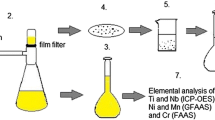Summary
Chemical analysis and materials research are linked together in manifold ways. Low contents of undesirable impurities and of alloying elements have a deciding influence, e.g., on mechanical properties, hot ductility and corrosion behavior of steel. Therefore trace analysis is of great importance for many questions in materials research. By way of examples the strong relationship between metallurgy, materials research, and chemical analysis will be explained.
In case of titanium there is a need for a reliable method for the Ti determination below 50 μg/g. On the other hand, Ti has to be determined in the range of 80 to 800 μg/g with a standard deviation of 10 μg/g in order to allow the production of fine-grained steels. Another example of modern steel analysis is the determination of low contents of calcium. Results obtained by ICP-spectrometry in the range of 5 to 40 μg/g are reported. Finally, the state of the art of trace analysis of steels is mentioned.
Similar content being viewed by others
Literatur
Broekaert IAC, Gaule T, Jenett H, Tölg G, Tschöpel P (1989) Fresenius Z Anal Chem 332:825
Koch KH (1987) Mikrochim Acta (Wien) I:151
Dillamore IL, Dulicu D (1972) Proc 25th Chemists' Conf Scarborough, Conf Proc 617/72:5
Conference Residuals, Additives and Materials Properties (1980) Philos Trans R Soc Lond A 295:1
Degenkolbe J, Kalwa G, Kaup K (1988) Stahl Eisen 108:527
STU-information Nr. 105 (1978) Effects of impurities on the hot ductility of austenitic stainless steels, Hrsg. Styrelsen för tekniste utveckling, Stockholm
Grabke HJ (1987) Steel Res 58:477
Kreitner F, Apfelmaier K (1985) In: Eisenhütte Österreich (Hrsg) Spurenelemente in Stählen, Verlag Stahleisen, Düsseldorf, S. 23
Moser A, Jöller A (1985) In: Eisenhütte Österreich (Hrsg) Spurenelemente in Stählen, Verlag Stahleisen, Düsseldorf, S. 35
Schimböck R, Ornig H (1985) In: Eisenhütte Österreich (Hrsg) Spurenelemente in Stählen, Verlag Stahleisen, Düsseldorf, S. 39
Engell H-J, Köhler M, Fleischer H-J, Thielmann R, Schürmann E (1984) Stahl Eisen 104:443
Akesson J, Lund T (1984) SKF Steel Techn Rep 7/84
Hirschfeld D, Thierig D (1989) Proc 42nd Chemists' Conf Scarborough
Flock J, Ohls K (1988) Fresenius Z Anal Chem 331:408
Ohls K (1989) Winter Conf on Plama Spectroscopy Reutte
Author information
Authors and Affiliations
Additional information
Herrn Prof. Dr. G. Tölg anläßlich der Vollendung seines 60. Lebensjahres gewidmet
Rights and permissions
About this article
Cite this article
Koch, K.H., Ohls, K. Beispiele zur Bedeutung der Spurenanalytik für die Werkstoffwissenschaften. Z. Anal. Chem. 335, 652–655 (1989). https://doi.org/10.1007/BF01204065
Received:
Accepted:
Issue Date:
DOI: https://doi.org/10.1007/BF01204065




